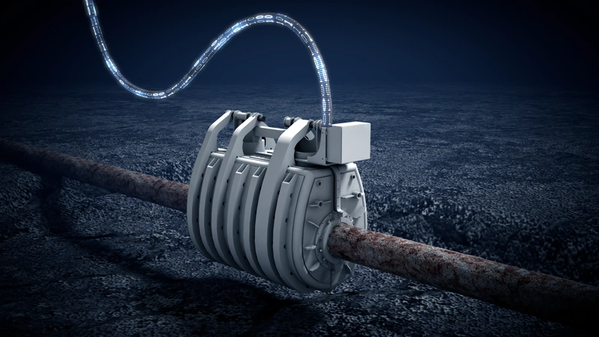For a deeper-dive into additive manufacturing, you can now subscribe to our Youtube channel, featuring discussion, de-briefs and shots of 3D printing in-action.
Norweigan subsea robotics specialist Kongsberg Ferrotech has revealed that it’s currently developing an underwater 3D printing technology for repairing seabed-level pipelines.
Designed to complement the capabilities of its existing aquatic robotics systems, the company’s upcoming metal additive manufacturing add-on is set to be used as a means of carrying out remote maintenance on damaged marine infrastructure, as well as rebuilding it where necessary.
“Advanced subsea robots give the customer major savings in both cost and time – performed in an environmentally friendly manner – without producing discharges to the sea,” said Christopher Carlsen, CEO of Kongsberg Ferrotech. “Our solutions have been in development for the past five years, and we will begin offering underwater composite repairs to the Southeast Asian market in Q3 2021.”
“With our Inspection, Maintenance and Repair (IMR)-robotic technology, we bring the workshop to the damage – not the damage to the workshop.”
Kongsberg Ferrotech’s AM ambitions
Kongsberg Ferrotech’s metal 3D printing project has seen it join forces with Equinor, SINTEF, Gassco and the Research Council of Norway to develop the technology for underwater Maintenance, Repair and Overhaul (MRO) applications.
Through the program, Kongsberg Ferrotech aims to produce an upgrade for its existing Subsea Flow Line Control and Repair (SFCR) robots, which enables them to carry out in-situ repairs on nautical flowlines. At present, the firm’s ‘Nauticus’ bot is capable of being lowered into the sea, establishing a vacuum and repairing any broken pipes, before returning to the surface without leaving any debris.
With its new “Subsea AM for Lifetime Extension” technology, however, the company says that an upgraded Nautilus could “significantly extend the lifetime” of multiple seafaring assets. In fact, while the firm is initially targeting the repair of damaged flowlines with its 3D printing process, it has also left the door open to developing other functionalities for its devices, that create opportunities in new sectors.

“The rapid development of 3D printing technology is creating new opportunities and markets going forward,” explained Brede Lærum, Head of 3D printing at Equinor. “Combining this technology with Kongsberg Ferrotech’s robots opens many exciting new possibilities for subsea repairs and modifications. We are looking forward to a close collaboration with our industry partners.”
Kongsberg Ferrotech’s technology may have been under development since 2016, but it has now reportedly passed deepwater composite repair testing at the Trondheim Fjord in Norway, and the firm says that it’s expected to be commissioned for its first commercial application “as early as 2022.”
“The collaboration with Equinor, Gassco, and SINTEF represents world-class expertise within operations of underwater installations, underwater transport systems, and research on metallic repair,” concluded Carlsen. “This unique opportunity to develop underwater 3D printing for lifetime extension is an important technology leap – not only for Kongsberg Ferrotech, but also for the industry.”
3D printing’s pipe-repairing potential
Adopting 3D printing within pipeline repair could turn out to be highly beneficial for nautical companies, providing them with cost and time savings, as well as potentially removing the need for downtime altogether. In the past, Chinese firm Nanfang Additive Manufacturing Technology has also conducted significant research with local partners into EBM 3D printing oil and gas line parts.
Unlike Kongsberg Ferrotech’s R&D program, Nanfang’s project took place above sea level, but it did yield a massive 400kg prototype pressure vessel cylinder. Likewise, in 2019, metal 3D printer manufacturer Titomic opted to license two CSIRO patents related to the additive manufacturing of titanium pipes, valves and continuous pipelines, with potential oil, gas and mining applications.
Elsewhere, on a much smaller scale, scientists at Tianjin University have 3D printed a customizable robot that’s capable of climbing and monitoring pipes at industrial facilities. Featuring soft bending mechanisms and modular grippers, the remote-controlled bot has been designed to prevent future factory production delays.
To stay up to date with the latest 3D printing news, don’t forget to subscribe to the 3D Printing Industry newsletter or follow us on Twitter or liking our page on Facebook.
Are you looking for a job in the additive manufacturing industry? Visit 3D Printing Jobs for a selection of roles in the industry.
Featured image shows Kongsberg Ferrotech’s Nautilus underwater repair system. Image via Kongsberg Ferrotech.


